A: First up we would like to inform you some of our frequency changes as VOV has revised its shortwave frequencies and broadcasting times.
B: We have stopped broadcasting our program on the frequency of 12005 khz from 1h-1h30 UTC and on 9625 khz from 0h-0h30 UTC.
A: On the frequency of 6175 khz we’ll add broadcasts at 0h-0h30 UTC and 1h00-1h30 UTC.
B: On the frequency of 9730 khz and 7280 khz our programs will be available at 19h-19h30 UTC and 21h30-22h UTC.
A: If you missed this information, please go to our website at vovworld.vn to check it again. We’ll also send you letters and emails to inform you of the changes. We hope to receive your technical feedback on reception quality very soon.
B: I’m reading an email from Staffan Crona, a Swedish shortwave listener for about 50 years ago. He wrote: “I’m interested in radio. Then radio and audio made me study electronics at Chalmers University of Technology. I also have an MBA from Gothenburgs business school. I have been working in many countries like Slovakia, Poland, Iran, China, USA and Iraq. I have gone to weddings in Poland, China and Thailand.”
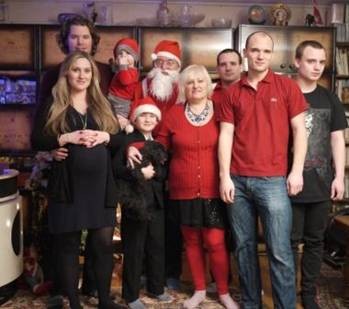 |
Staffan Crona's family photo
|
A: It’s a pity that you haven’t been to Vietnam although you said you have some long time Vietnamese friends. You’ve stayed friends for more than 20 years now since your time at Chalmers University. From now on you will have more Vietnamese friends in VOV’s English section. We hope Vietnam will be included in your travel plans soon.
B: Staffan told us an about his family history: “My private interest, besides technology, is history and my family ancestor history. In my fairytale ancestor history I go back to Ramses in Egypt, but already 30 generations back. With two parents in every generation we have 10 billion ancestors mathematically so the history might be true.”
A: Wow, that’s an impressive calculation. It’s great to have a correspondence with you, Staffan, and see a picture of your family. We’ll verify your reception report and we trust you’ll receive our QSL card soon.
B: We thank Ashik Eqbal Tokon of Bangladesh for his congratulations to Vietnam for marksman Hoang Xuan Vinh’s gold medal in the men’s 10-meter air pistol event. A dream has come true: Vietnam’s 1st Olympic gold medal.
A: The 41-year-old marksman gained 10.7 points in the final round, bringing his total score to 202.5 for 20 shots. Vinh, who is a military officer, said he hopes his victory will encourage in young Vietnamese people a love for shooting.
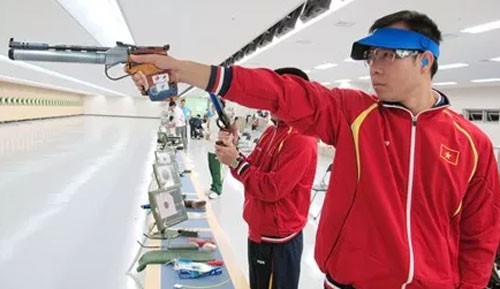 |
| Marksman Hoang Xuan Vinh |
B: Sure it will. He has been a model of strong will in training and competing. Last week it seemed that every Vietnamese facebooker had shared the photo of Vinh receiving his gold medal. Stories of Vinh’s arduous training since his loss at the London Olympics in 2012 are inspiring.
A: Vietnam’s hope for more medals at the 2016 Summer Olympics in Rio de Janeiro is fading. Swimmer Nguyen Thi Anh Vien failed to advance when she finished 33rd in the 200m individual medley. She had come in 9th in the qualifying round of the women’s 400m individual medley.
B: Fencer Nguyen Thi Le Dung lost to Kim Jiyeon of the Republic of Korea in the round of 32 of the women’s sabre event. In rowing, Ho Thi Ly and Ta Thanh Huyen finished 19th out of 20 participating teams. Vietnamese athletes in Judo, gymnastics, weightlifting, and rowing didn’t perform as well as expected.
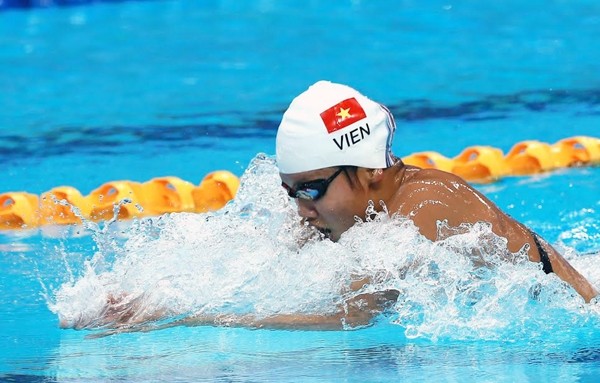 |
| Vietnamese swimmer Nguyen Thi Anh Vien |
A: Here I have an email from Chinmoy Mahato, President of the International Radio Listeners Club of India. He said he tried to listen to VOV on shortwave but could not find us. He has visited our website to read and listen to our programs. His club has 65 members who are interested in social, cultural, political, and economic news in other countries, including Vietnam.
B: We’ll send your club our latest frequency and program guide so you can find us on shortwave and enjoy your hobby of Dx’ing.
A: Ryoichi Kawanishi, a 19-year-old Japanese student, listened to our Saturday program on July 2 on the frequency of 9840 khz. He wants to know the exact names of the songs we played on the program so he can look them up and maybe buy a CD. Ryoichi said “they all sounded nice to my ears and have really got my interest.”
B: On that Weekend Music segment, we played songs for which musician Phan Huynh Dieu set love poems to music. We’ll post the songs on the Vietnamese Music menu on our website so you can hear the songs again and find related information.
A: Many of our listeners received our QSL cards with images of natural and historical sites in Vietnam and they want to know more about those places. They have shown a big interest in collecting VOV’s QSL cards. Richard Lemke of Canada said he has almost completed collecting 8 QSL cards from VOV.
B: Mr. Muralidhar continues to send in reception reports and wants a QSL card with the image of a Peach blossom in Moc Chau for his collection.
A: Atish Bhattacharya wrote: “I feel wonderful to let you know that I have received the beautiful VOV QSL card from you. I am overwhelmed with joy to have and add this valuable card to my collection. I am very thankful to you for sending this marvelous verification card with a picture of Long Bien Bridge designed by world famous French architect Gustave Eiffel. I would like to know more about this bridge. I am also grateful to you for sending me a very nice bookmark. It's really precious to me.”
B: In the capital city of Hanoi, Hoan Kiem lake with its special green water and the red bridge named The Huc are considered the symbols of an elegant and charming ancient city, while the Red river and Long Bien bridge may be seen as the symbol of a courageous capital at war.
A: The Long Bien Bridge was constructed between 1889 and 1902 during France’s occupation of the country. Though the bridge was designed by the French, it was built by Vietnamese workers with indigenous construction materials like wood from Phu Tho, Yen Bai, and Thanh Hoa province, cement from Hai Phong, and Long Tho lime from Hue.
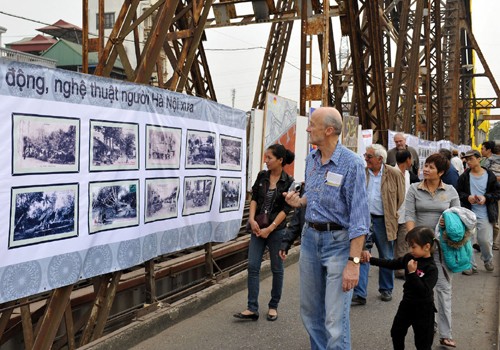 |
Visitors to an exhibition organized on the walking side of Long Bien bridge
|
B: The bridge was formerly named the Paul Doumer bridge by the French, but the Vietnamese have called it Long Bien or Cai River Bridge for a long time, and Long Bien has become the most popular name of the bridge. Originally, Long Bien had 19 spans and was the first steel bridge across the Red River. It was one of the four greatest bridges in the world at the time it was built.
A: Today, Long Bien is just one of five bridges that cross the Red River in Hanoi. Many people say Long Bien bridge is the best place to watch the sunrise or the sunset and take nice photos of the sandbar. Lots of brides and grooms choose Long Bien Bridge as a nice background for wedding photos. Youths take photos on the bridge and camp on the river bank or on sandbar covered with lush greenery.
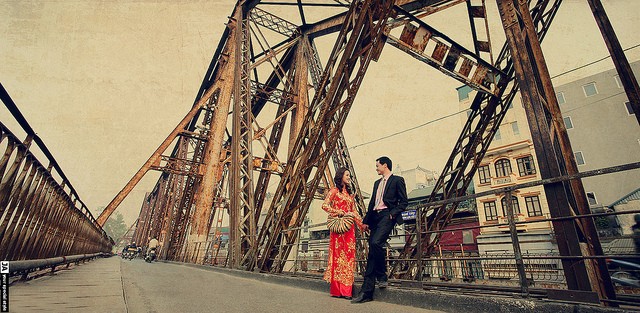 |
| Couples prefer to take wedding photos on Long Bien bridge |
B: Tourists can rent a motorbike, and remember go on the left hand side of the bridge, or walk from the centre of Hanoi to here. It’s just about 1km from Hanoi’s Old Quarter to Long Bien bridge.
A: This week we acknowledge letters and reception report from Richard Nowak, Igor Kuzminykh of Russia, Javed Iqbal of Pakistan, John Rutledge of China, Stefan Schliephacke, Enzo Pistone of Italy, and Toshiya Nishimura of Japan. Thank you for listening to VOV on shortwave and online and reading our website. We’ll verify your reception reports and hope you’ll receive our QSL cards soon.
B: We welcome your feedback at our station: English Section, Overseas Service, Voice of Vietnam, 45 Ba Trieu Street, Hanoi, Vietnam. Our email address is englishsection@vov.org.vn. Good bye until next time.